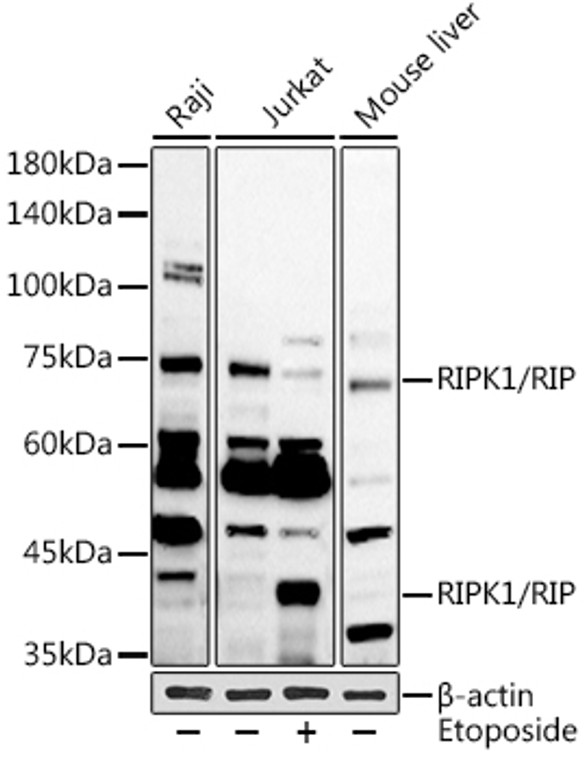| Host: |
Rabbit |
| Applications: |
WB/IHC/IF/IP |
| Reactivity: |
Human/Mouse/Rat |
| Note: |
STRICTLY FOR FURTHER SCIENTIFIC RESEARCH USE ONLY (RUO). MUST NOT TO BE USED IN DIAGNOSTIC OR THERAPEUTIC APPLICATIONS. |
| Short Description: |
Rabbit polyclonal antibody anti-RIPK1 (100-200) is suitable for use in Western Blot, Immunohistochemistry, Immunofluorescence and Immunoprecipitation research applications. |
| Clonality: |
Polyclonal |
| Conjugation: |
Unconjugated |
| Isotype: |
IgG |
| Formulation: |
PBS with 0.05% Proclin300, 50% Glycerol, pH7.3. |
| Purification: |
Affinity purification |
| Dilution Range: |
WB 1:500-1:1000IHC-P 1:50-1:200IF/ICC 1:50-1:200IP 1:50-1:200 |
| Storage Instruction: |
Store at-20°C for up to 1 year from the date of receipt, and avoid repeat freeze-thaw cycles. |
| Gene Symbol: |
RIPK1 |
| Gene ID: |
8737 |
| Uniprot ID: |
RIPK1_HUMAN |
| Immunogen Region: |
100-200 |
| Immunogen: |
A synthetic peptide corresponding to a sequence within amino acids 100-200 of human RIPK1/RIP (NP_003795.2). |
| Immunogen Sequence: |
LMHVLKAEMSTPLSVKGRII LEIIEGMCYLHGKGVIHKDL KPENILVDNDFHIKIADLGL ASFKMWSKLNNEEHNELREV DGTAKKNGGTLYYMAPEHLN D |
| Post Translational Modifications | (Microbial infection) Proteolytically cleaved by S.flexneri OspD3 within the RIP homotypic interaction motif (RHIM), leading to its degradation and inhibition of necroptosis. Proteolytically cleaved by CASP8 at Asp-324. Cleavage is crucial for limiting TNF-induced apoptosis, necroptosis and inflammatory response. Cleavage abolishes NF-kappa-B activation and enhances the interaction of TRADD with FADD. Proteolytically cleaved by CASP6 during intrinsic apoptosis. RIPK1 and RIPK3 undergo reciprocal auto- and trans-phosphorylation. Phosphorylation of Ser-161 by RIPK3 is necessary for the formation of the necroptosis-inducing complex. Phosphorylation at Ser-25 represses its kinase activity and consequently prevents TNF-mediated RIPK1-dependent cell death. Phosphorylated at Ser-320 by MAP3K7 which requires prior ubiquitination with 'Lys-63'-linked chains by BIRC2/c-IAP1 and BIRC3/c-IAP2. This phosphorylation positively regulates RIPK1 interaction with RIPK3 to promote necroptosis but negatively regulates RIPK1 kinase activity and its interaction with FADD to mediate apoptosis. Deubiquitinated by USP7.this modification is required for TNF-alpha-induced apoptosis. Ubiquitinated with 'Lys-11'-, 'Lys-48'-, 'Lys-63'- and linear-linked type ubiquitin. Polyubiquitination with 'Lys-63'-linked chains by TRAF2 induces association with the IKK complex. Deubiquitination of 'Lys-63'-linked chains and polyubiquitination with 'Lys-48'-linked chains by TNFAIP3 leads to RIPK1 proteasomal degradation and consequently down-regulates TNF-alpha-induced NF-kappa-B signaling. 'Lys-48'-linked polyubiquitination by RFFL or RNF34 also promotes proteasomal degradation and negatively regulates TNF-alpha-induced NF-kappa-B signaling. Linear polyubiquitinated.the head-to-tail linear polyubiquitination ('Met-1'-linked) is mediated by the LUBAC complex and decreases protein kinase activity. Deubiquitination of linear polyubiquitin by CYLD promotes the kinase activity. Polyubiquitinated with 'Lys-48' and 'Lys-63'-linked chains by BIRC2/c-IAP1 and BIRC3/c-IAP2, leading to activation of NF-kappa-B. Ubiquitinated with 'Lys-63'-linked chains by PELI1. Ubiquitination at Lys-377 with 'Lys-63'-linked chains by BIRC2/c-IAP1 and BIRC3/c-IAP2 is essential for its phosphorylation at Ser-320 mediated by MAP3K7. This ubiquitination is required for NF-kB activation, suppresses RIPK1 kinase activity and plays a critical role in preventing cell death during embryonic development. (Microbial infection) Glycosylated at Arg-603 by enteropathogenic E.coli protein NleB1: arginine GlcNAcylation prevents homotypic/heterotypic death domain interactions. |
| Function | Serine-threonine kinase which is a key regulator of TNF-mediated apoptosis, necroptosis and inflammatory pathways. Exhibits kinase activity-dependent functions that regulate cell death and kinase-independent scaffold functions regulating inflammatory signaling and cell survival. Has kinase-independent scaffold functions: upon binding of TNF to TNFR1, RIPK1 is recruited to the TNF-R1 signaling complex (TNF-RSC also known as complex I) where it acts as a scaffold protein promoting cell survival, in part, by activating the canonical NF-kappa-B pathway. Kinase activity is essential to regulate necroptosis and apoptosis, two parallel forms of cell death: upon activation of its protein kinase activity, regulates assembly of two death-inducing complexes, namely complex IIa (RIPK1-FADD-CASP8), which drives apoptosis, and the complex IIb (RIPK1-RIPK3-MLKL), which drives necroptosis. RIPK1 is required to limit CASP8-dependent TNFR1-induced apoptosis. In normal conditions, RIPK1 acts as an inhibitor of RIPK3-dependent necroptosis, a process mediated by RIPK3 component of complex IIb, which catalyzes phosphorylation of MLKL upon induction by ZBP1. Inhibits RIPK3-mediated necroptosis via FADD-mediated recruitment of CASP8, which cleaves RIPK1 and limits TNF-induced necroptosis. Required to inhibit apoptosis and necroptosis during embryonic development: acts by preventing the interaction of TRADD with FADD thereby limiting aberrant activation of CASP8. In addition to apoptosis and necroptosis, also involved in inflammatory response by promoting transcriptional production of pro-inflammatory cytokines, such as interleukin-6 (IL6). Phosphorylates RIPK3: RIPK1 and RIPK3 undergo reciprocal auto- and trans-phosphorylation. Phosphorylates DAB2IP at 'Ser-728' in a TNF-alpha-dependent manner, and thereby activates the MAP3K5-JNK apoptotic cascade. Required for ZBP1-induced NF-kappa-B activation in response to DNA damage. |
| Protein Name | Receptor-Interacting Serine/Threonine-Protein Kinase 1Cell Death Protein RipReceptor-Interacting Protein 1Rip-1 |
| Database Links | Reactome: R-HSA-140534Reactome: R-HSA-168927Reactome: R-HSA-1810476Reactome: R-HSA-2562578Reactome: R-HSA-3295583Reactome: R-HSA-3371378Reactome: R-HSA-5213460Reactome: R-HSA-5218900Reactome: R-HSA-5357786Reactome: R-HSA-5357905Reactome: R-HSA-5357956Reactome: R-HSA-5675482Reactome: R-HSA-5689880Reactome: R-HSA-5689896Reactome: R-HSA-69416Reactome: R-HSA-75893Reactome: R-HSA-9013957Reactome: R-HSA-933543Reactome: R-HSA-937041Reactome: R-HSA-9679191Reactome: R-HSA-9686347Reactome: R-HSA-9692913Reactome: R-HSA-9693928 |
| Cellular Localisation | CytoplasmCell Membrane |
| Alternative Antibody Names | Anti-Receptor-Interacting Serine/Threonine-Protein Kinase 1 antibodyAnti-Cell Death Protein Rip antibodyAnti-Receptor-Interacting Protein 1 antibodyAnti-Rip-1 antibodyAnti-RIPK1 antibodyAnti-RIP antibodyAnti-RIP1 antibody |
Information sourced from Uniprot.org
12 months for antibodies. 6 months for ELISA Kits. Please see website T&Cs for further guidance








